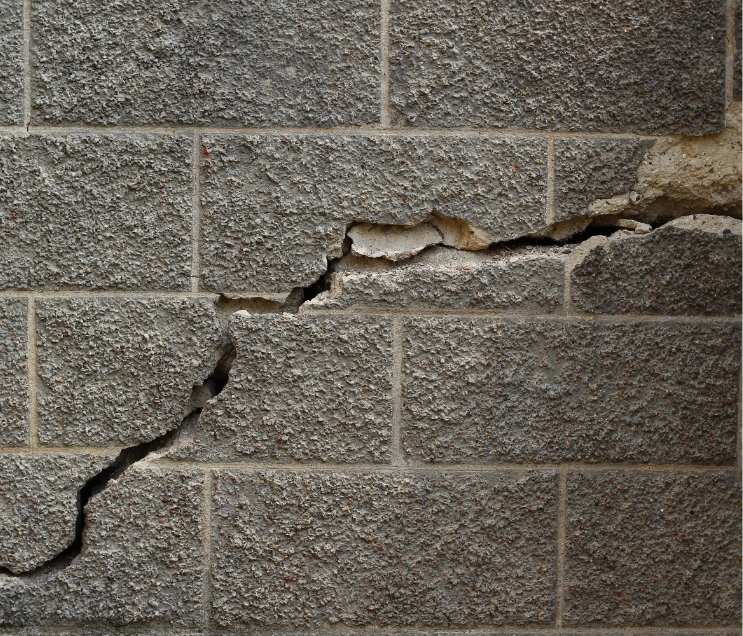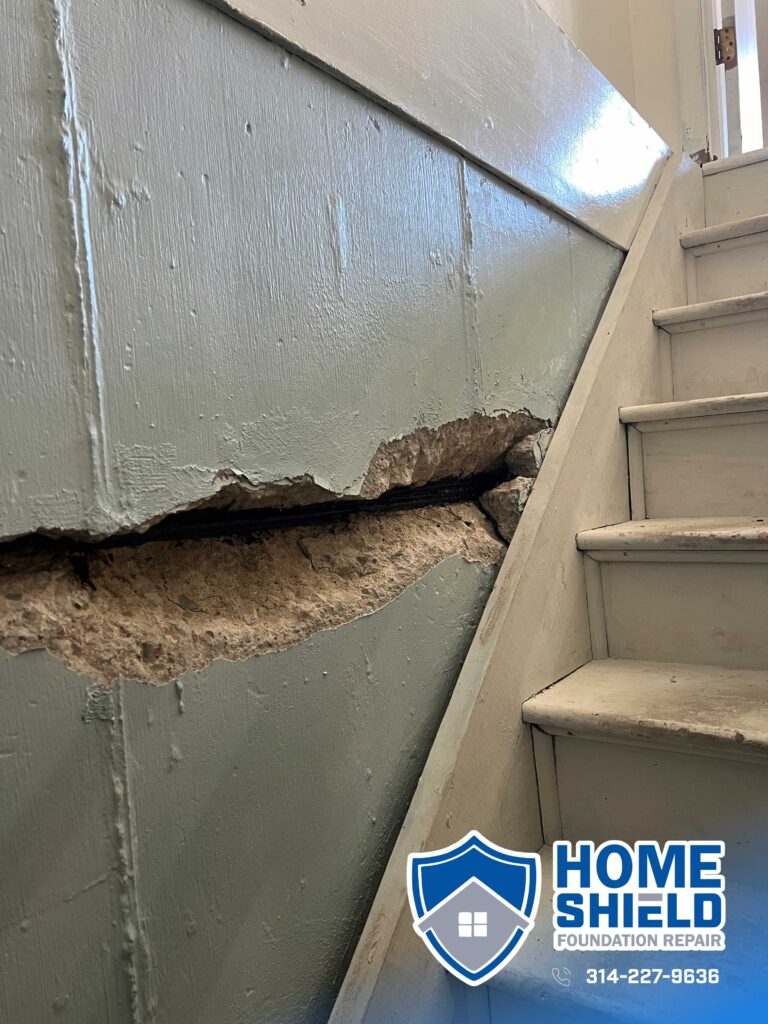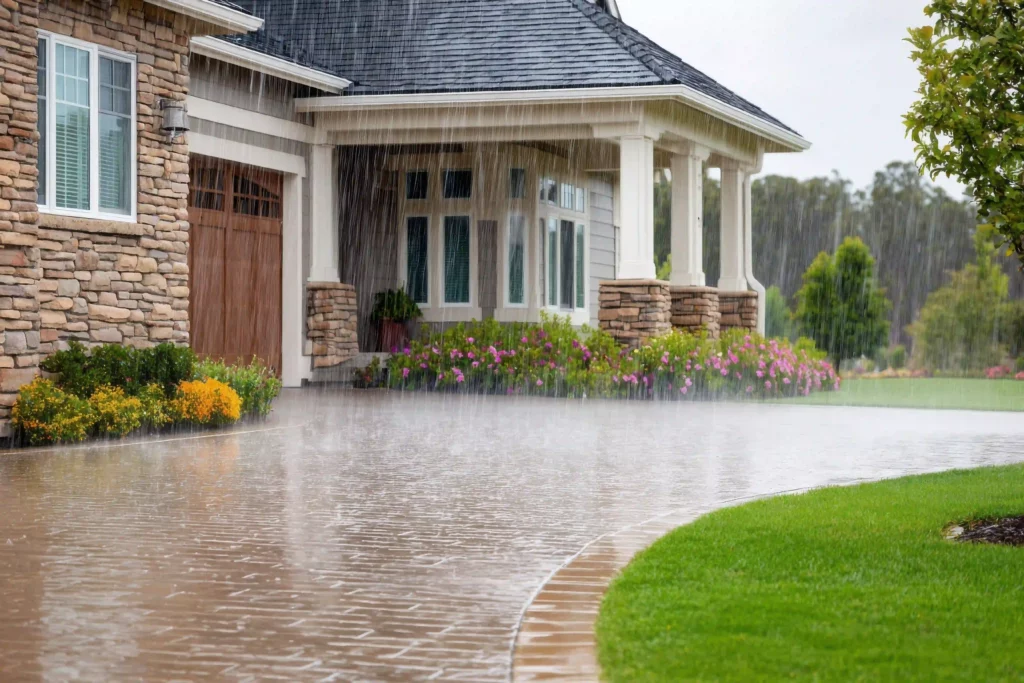
August 13, 2025
Why Your Foundation Is Cracking: A Homeowner’s Guide to Missouri Clay Soil
Have you ever walked around your home and noticed a crack in your basement wall or foundation? If so, you’re not alone. For homeowners across Missouri, especially in St. Louis County, St. Charles, Lincoln, and Warren, foundation cracks are a common and often concerning sight.
While they may seem minor, they’re often a sign of a much bigger problem lurking beneath your home: expansive Missouri clay soil.
At Home Shield Foundation Repair, we know firsthand how Missouri’s unique geology affects homes. We’re here to help you understand why your foundation is cracking, what to look for, and how to find a lasting solution. In this guide, we’ll explain:
- The different types of foundation cracks you might see
- Why Missouri soil creates so many foundation issues
- When to worry (and when not to)
- The effective solutions for protecting your home
Understanding the Types of Foundation Cracks
Before diving into the root causes, knowing what you’re looking at is helpful. Foundation cracks can tell a story, and understanding the type of crack is the first step toward diagnosing the problem.
- Vertical Cracks: These run up and down the foundation wall. They are often caused by the natural settling of a new home and may not be a major concern if narrow and not growing. However, they can widen over time due to soil shifts, allowing water to seep.
- Stair-Step Cracks: As the name suggests, these appear in block foundations and follow the mortar joints in a stair-step pattern. They are a classic sign of differential settlement, meaning one part of your foundation moves more than another. This is often linked to soil expansion or contraction.
- Horizontal Cracks: This is considered the most serious type of crack. Horizontal cracks are a strong indicator of hydrostatic pressure, which is the force exerted by saturated soil pushing against your foundation walls. If you see this type of crack, especially with accompanying bowing or leaning, it’s a red flag.
- Diagonal Cracks: These cracks often appear at corners or near openings like windows and doors. They usually indicate uneven settling or when the soil pulls away from the foundation.
- Cracks with Moisture Intrusion: Any crack that leaks water during heavy rain or has visible white, powdery stains (efflorescence) should be addressed immediately. These are signs of a crack and a pathway for moisture, which can lead to mold growth and poor indoor air quality.

The Real Culprit: Why Missouri Soil is so Problematic
Missouri’s geology features a high concentration of expansive clay, especially in Eastern and Central counties. This soil is the primary cause of many foundation issues because it behaves predictably, but in a way that’s bad for your home.
- It Acts Like a Sponge: Clay soil absorbs water and swells after heavy rainfall, increasing in volume and pressing against your foundation walls with immense force.
- It Shrinks When Dry: During long, dry spells and droughts, the soil shrinks and pulls away from your foundation, creating voids and causing your home to settle.
- It Never Stops: These constant cycles of swelling and shrinking repeat year after year. The result is a foundation that is pushed, pulled, and shifted over time, leading to the cracks you see.

When to Worry About Foundation Cracks: Your Red Flags
While some hairline cracks are harmless, here are the warning signs that mean it’s time to call a professional for an inspection:
- Cracks wider than 1/8 inch. A crack you can fit a nickel or a pencil into is a clear sign of movement.
- Cracks that are actively growing. Take a picture and measure it monthly. If it’s getting bigger, it’s a problem.
- Horizontal or stair-step cracks. These are the most common signs of structural movement and should be inspected immediately.
- Water leaking through cracks. This is a direct sign of a moisture problem that can lead to mold and other damage.
- Bowing, leaning, or bulging foundation walls. This means your foundation is under severe pressure and is losing its structural integrity.
- Cracks combined with other interior issues. If you also notice sagging floors, sticking doors or windows, or a musty smell, it’s likely connected to a foundation problem.


Weather Makes the Problem Worse
Missouri’s unpredictable weather patterns only intensify the clay soil problem.
- Heavy Rain and Flooding: Spring and summer rains can oversaturate the ground, leading to extreme hydrostatic pressure against your foundation.
- Droughts: Long periods without rain can cause the soil to shrink dramatically, leading to foundation settlement.
- Freeze-Thaw Cycles: The ground freezes and expands in winter, putting additional pressure on your foundation before thawing and contracting in the spring.
A Real-Life Example: Horizontal Cracks in O’Fallon
A homeowner in O’Fallon, MO, contacted Home Shield after noticing wide, horizontal cracks forming across two of their basement walls. After weeks of heavy spring rain, the walls began bowing inward, a sign of significant pressure.
Our team diagnosed the problem as hydrostatic pressure from the saturated clay soil. To address the issue, we created a customized plan that included:
- Carbon fiber straps to stabilize the bowing walls and prevent further movement.
- Polyurethane crack injection to seal the cracks and stop water from leaking into the basement.
- Downspout extensions and regrading to move water away from the foundation and prevent future pressure buildup.
The result was a stable, sealed foundation and peace of mind for the family, knowing their home was protected from the ground up.
Effective Solutions for Missouri Homes
At Home Shield Foundation Repair, we use region-specific solutions designed to handle the unique challenges of Missouri’s clay soils. We don’t just fill cracks; we address the root cause of the problem.
- Crack Repair Injections: We use specialized injections to not only seal cracks but also provide structural stability. Epoxy injection is used for structural repairs, while polyurethane injection is used for waterproofing and remains flexible to move with the foundation.
- Wall Reinforcement: For walls that are bowing or leaning, we use strong reinforcement methods like carbon fiber straps or steel I-beams to stop further movement and add lasting strength to your foundation.
- Soil and Water Management: We believe in a proactive approach. This includes fixing exterior drainage with solutions like downspout extensions and regrading to get water away from your foundation. For more severe issues, we may recommend an interior drainage system to keep your basement dry.
- Concrete Leveling for Exterior Slabs: If the cracks are extending to your sidewalks, porches, or garage floors, we can use polyurethane foam injection to raise and stabilize the concrete, preventing trip hazards and stopping water from pooling.
Frequently Asked Questions (FAQs)
Here are some of the most common questions homeowners ask us.
Are vertical cracks in my basement wall normal?
Hairline vertical cracks are common in new homes as the concrete cures. However, if they grow or leak, they should be sealed to prevent water damage.
What is the most dangerous type of foundation crack?
Horizontal cracks, especially when paired with bowing walls, are the most serious. They indicate a major pressure problem that can compromise your home’s structural integrity.
How do I monitor a crack to see if it’s getting worse?
You can use a ruler or even a piece of tape to mark the ends of the crack. Take photos monthly to track its growth. If it widens, call an expert.
Do foundation cracks always mean I need an expensive repair?
Not always. Some cracks are superficial. But it’s always better to get them inspected early. Catching a small problem can save you thousands of dollars in the long run.
Can Missouri’s weather really cause foundation cracks?
Yes. The expansive and contracting nature of Missouri’s clay soil, combined with heavy rain, droughts, and freeze-thaw cycles, is a leading cause of foundation cracks and structural damage.
Our Service Areas
We proudly serve homeowners across Eastern Missouri, including:
- St. Louis County
- St. Charles County
- Warren County
- Lincoln County
- Wentzville, Troy, O’Fallon, and surrounding communities
Our team understands the unique challenges of building on Missouri’s clay soil and how to provide effective, long-lasting repairs.
Schedule a Free Crack Inspection Today
Foundation cracks don’t fix themselves and the weather in Missouri isn’t going to get any easier on your home.
That’s why Home Shield Foundation Repair offers free inspections with expert guidance and no pressure. We’ll walk your property, examine the cracks, and give you a tailored repair plan that protects your home for years to come.